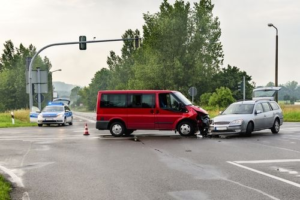Left turn accidents are one of the most common types of car collisions that occur on roadways. They can be particularly devastating because they often involve drivers colliding with other vehicles while making left turns, resulting in serious injuries and even fatalities. While left turns may seem relatively harmless, they can be dangerous if done without caution or proper preparation.

Accidents frequently occur when drivers are making left-hand turns. Turns like these take them across the flow of traffic, which can increase the likelihood of collisions.
Most people naturally assume that the driver who is turning left is to blame when accidents like these occur. By law, they are required to yield the right-of-way to oncoming traffic. Logically, then, it would seem like they were at fault if an accident occurred. As it turns out, however, that isn't always the case.
Drivers who are making left-hand turns always have to wait for the other traffic to clear before completing their turn. Based on that, it naturally would seem as if the driver who was turning was the one responsible if an accident occurred. In many cases, that is true.
For instance, if a driver is turning left on a green light and they don't see an approaching vehicle, they could accidentally turn in front of them or into the side of their vehicle, causing a collision as a result. In this case, the driver making the left-hand turn is definitely to blame since they should have yielded to the oncoming traffic.
Not all accidents like these are so clear-cut, however. For instance, imagine that a driver is turning left at an intersection. They have a green turn arrow, telling them that it is okay to turn. In this case, they have the right-of-way thanks to the green turn arrow. If another driver runs a red light and collides with them as a result, that driver would be to blame since they didn't yield the right-of-way to the driver with the green turn arrow.

South Florida Victims . . .
NEED HELP WITH A LEFT-TURN ACCIDENT?
Things can also get a little bit tricky if the other driver who was involved in the accident was driving in a way that was negligent or reckless. For instance, if the driver of the other vehicle was intoxicated and was exceeding the speed limit, they most likely would be considered at fault since their negligent behavior caused the accident to occur. The driver turning left may not have had time to stop before their vehicle arrived at the intersection, resulting in a collision. In this case, the accident was caused by the other driver going too fast – not by the driver turning left failing to yield the right-of-way.
It is difficult to gauge how long it will take for a vehicle to reach an intersection if the driver is exceeding the speed limit. As a result, the driver turning left may have assumed that they had more time to complete their turn, which is why the driver who was speeding is usually assigned blame.
This should give you a better idea of how the authorities figure out who was at fault in left-turn auto accidents. While it is easy to identify who is to blame in certain accidents, others are a lot more complex. The police will usually analyze the accident scene carefully, trying to reconstruct what happened. Based on their findings, they will then determine which driver is responsible for causing the accident to occur.

South Florida Victims . . .
For a FREE Case Evaluation on your Left-Turn accident . . .
Frequently Asked Questions
Who is at Fault in a Left Turn Accident?
Generally, when two vehicles crash while both are making a left turn, each driver may be found partially at fault. The percentage of fault depends on the circumstances of the accident and the state where it occurred. For instance, if one motorist made an illegal turn or failed to yield to an oncoming car, they would likely be assigned more of the blame for the crash than their counterpart.
What are some common mistakes when making left turns?
Some of the most common mistakes when making left turns are not checking blind spots, assuming the coast is clear, and failing to properly judge the speed of oncoming traffic. Additionally, some drivers do not pay attention to any signage at an intersection which can also cause a dangerous left turn accident.
What are the dangers of unprotected left turns?
Unprotected left turns can be especially dangerous as vehicles may move into each other's paths, leading to collisions that can cause serious injuries. Furthermore, making a unprotected left turn does not allow for any time to prepare for a potential collision, since you're needed to yield given way and rely on the other driver reacting in time.
What are the main causes for left turn head on collision?
Head-on collisions between two vehicles can be caused by a variety of factors, but the main cause is drivers attempting to make unsafe left turns. Drivers may fail to yield to oncoming traffic, may misjudge the speed or distance of another vehicle, or become distracted while turning. Driver impairment from alcohol or drugs, as well as driving at high speeds around curves or over hills can also increase the chances for a head-on collision.
What 3 steps should be followed when making a left turn?
Making a left turn can be hazardous if done incorrectly, so it's important to follow these three steps to help ensure safety when turning left: check for oncoming traffic, signal and yield the right of way, and slowly accelerate into the turn. By following these simple steps, you can help avoid potential left turn accidents.
